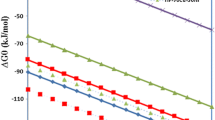Abstract
An attempted was made to produce nickel powder in an electroless nickel plating bath using Ti (III) ions as the reducing agent. The crystallite diameter of the obtained nickel powder was about 1.7 nm. This nickel powder magnetically formed chain-like clusters, because the primary particles were small. The resistance of the chain-like powder paste-applied sheets was less than about 1/8 compared to that of the existing spherical powder-applied sheets. To exhibit the same resistance as the spherical nickel powder-applied sheets, the amount of nickel can be markedly reduced by applying the chain-like nickel powder.











Similar content being viewed by others
References
Toray Research Center (1999) New development of nanoparticles. Toray Research Center, Tokyo
Koizumi M, Moku Y, Chujo S, Niihara K (2001) Newest technology for nanomaterials. CMC, Tokyo
Uchida M (1997) J Surf Finish Soc Jpn 48:400
Gutzeit G (1959) Plating 46:1275
Narcus H (1967) Plating 54:389
Warwick ME, Shirley BJ (1980) Trans Inst Met Finish 58:9
Obata K, Sonoda T, Dohi N (1982) J Met Finish Soc Jpn 33:375
Sviridov VV, Shevchenko GP, Susha AS, Diab NA (1996) J Phys Chem 100:19632
Nakao S, Kim D, Obata K, Inazawa S, Majima M, Koyama K and Tani Y (2001) Abstracts of Frontiers of Surface Engineering 2001 (FSE 2001), Nagoya, Japan, Oct 28–Nov 1:232
Inazawa S, Majima M, Koyama K, Tani Y, Nakao S, Kim D and Obata K (2001) Abstracts of Frontiers of Surface Engineering 2001 (FSE 2001), Nagoya Japan, Oct 28–Nov 1:231
Nakao S, Kim D, Obata K, Inazawa S, Majima M, Koyama K, Tani Y (2003) Surf Coat Technol 169–170:132
Inazawa S, Majima M, Koyama K, Tani Y, Nakayama S, Nakao S, Kim D, Obata K (2002) J Surf Finish Soc Jpn 53:694
Inazawa S, Majima M, Koyama K, Tani Y, Nakayama S, Nakao S, Kim D, Obata K (2003) J Surf Finish Soc Jpn 54:488
Inazawa S, Majima M, Kariya A, Koyama K, Nakayama S, Nakao S, Kim D, Obata K (2004) J Surf Finish Soc Jpn 55:741
Yagi S, Murase K, Tsukimoto S, Hirato T, Awakura Y (2005) J Electrochem Soc 152(9):C588–C592
Author information
Authors and Affiliations
Corresponding author
Rights and permissions
About this article
Cite this article
Inazawa, S., Majima, M., Koyama, K. et al. Production of nickel powder by the titanium redox method and its application to conductive materials. J Appl Electrochem 38, 1211–1216 (2008). https://doi.org/10.1007/s10800-008-9535-1
Received:
Revised:
Accepted:
Published:
Issue Date:
DOI: https://doi.org/10.1007/s10800-008-9535-1




